

The institution of the Caliphate started after the demise of Prophet Mohammad. The reason for the innovation of the institution of the Caliph was that Muhammad never named his successor and after his death, the power was transferred to Ummah.
Ummah decided to name a Caliph, who will be considered the successor and deputy of Muhammad. The Caliph was the sole sovereign of the Caliphate and Muslim Ummah all over the world. The Caliph acted as the spiritual as well as the political leader of the Muslim world. The Caliph aimed to include the tribes in the Muslim world. Another objective for Calipha was to make their Caliphate strong and for that, they needed to allocate resources. Some Caliphs imposed taxes and trade duties but they were not enough to keep up the big Caliphate so they started military expeditions for gaining resources.
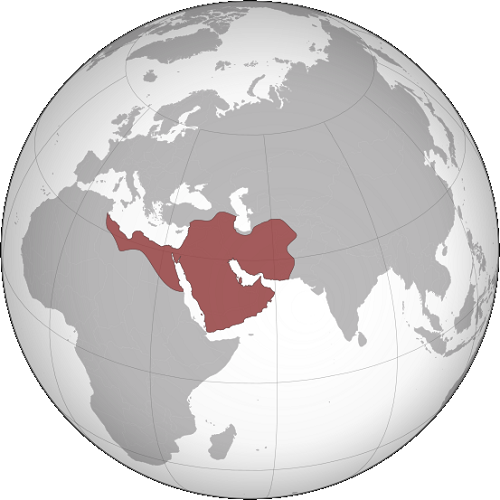
The Rashidun Empire reached its greatest extent under Caliph Uthman, in 654
Ali Zifan, CC BY-SA 4.0
The first Caliphate was the Rashidun Caliphate and Abu-Bakr, a close associate of Muhammad was made the Caliphin in 632 AD.
The Rashidun Caliphate reigned till 661AD. The Rashidun Caliphate was succeeded by the Umayyad Caliphate, which was established by Uthman’s cousin Mu’awiya in 661 AD. After the Assassination of Uthman, the next Caliph Ali was not liked by Muawiyya and other factions. His reign was filled with civil wars and he had to shift his capital from Madina to the garrison city of Kufa. Ali was assassinated and a new Caliphate was established by Muawiyya and he became the new Caliph in 661 CE.
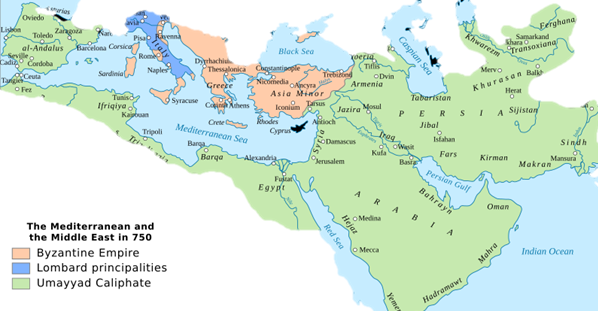
Caliphate
Constantine Plakidas, CC BY-SA 4.0
The Ummahyad dynasty was founded by the Caliph Uthman’s cousin Mu’awiya in the year 661 AD.
Muawiyya was Governor of Syria under the Rashidun Caliphate.
After establishing the Caliphate, Ummahyads suppressed the rebellion of other sects and all the followers of the previous Caliph
The reign of the Ummahyad dynasty was filled with strong political authority with the help of brute force.
They expanded the Caliphate to North Africa, Spain and some parts of the Indian subcontinent. They had the biggest territories in the history of the Caliphate.
The much-expanded size of the empire later became the reason for many civil wars and finally the end of the Umayyad dynasty in 750 AD.
He was the founder of the Umayyad Dynasty and he was the cousin of the earlier Caliph Uthman.
Mu’awiya was the governor of Syria during Uthman’s reign.
He ruled from the year 661 to 680, with stability and he suppressed the rebellions.
He was a clever politician and shrewd diplomat, he convinced Hassan, son of Caliph Ali, to abdicate the throne in exchange for a handsome pension.
He became Caliph unchallenged and ruled for 20 years, which was longer than any recent Caliph.
He shifted his capital to Damascus and brought many administrative reforms like police and the appointment of Diwans for local administration.
He was known for his military campaigns in modern-day Afghanistan, Pakistan and Morocco.
He adopted the administrative structure of the Benzathine empire.
The most significant reform introduced by him was the hereditary succession for Caliph.
He made the Umayyad Caliphate an Imperial power and he had the support of loyal Syrian soldiers.
He became the Caliph in the year 685 CE and ruled till 705 CE.
He also adopted the expansionist policy and sent military expeditions to Sindh, and Central Asia.
He retained his Arabic lineage and made Arab the official language and he replace the Persian and Greeks from the financial administration with the Arabs.
He introduced a new Arabic coin, which replaced the old benzathine and Sasanian coins.
He built the famous Dome of the Rock in Jerusalem.
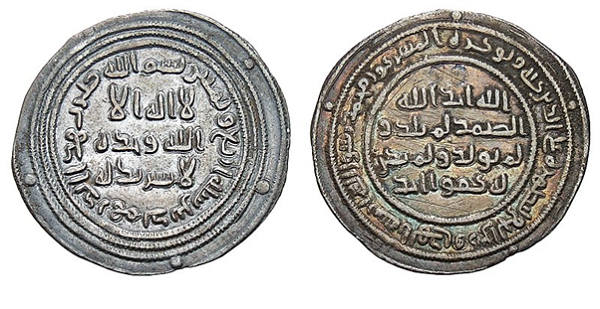
Arabic Coins During Abd-al-Malik
Münzkabinett Berlin, Public domain, via Wikimedia Commons
After the death of Abd-Al-Malik, his big empire disintegrated, and different started rebellions against the Caliphate. Multiple civil wars grew which decreased the size of the empire.
Many successors of Abd-Al-Malik tried to control the empire but they couldn’t.
The stability only came after the succession of Hisham, on the throne and he became the Caliph in the year 724 AD and reigned till 743 AD.
He succeeded in curbing the rebellion and started focusing on regaining territories.
He centralized the Muslim community and gave preference to Syrian soldiers which angered the Arabs.
When he died in 743AD, the empire again fell into many civil wars and lost its stability
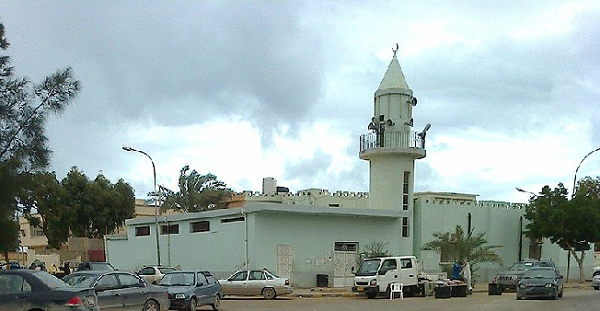
Hisham ibn al Mosque, Benghazi
Maher27777, Public domain, via Wikimedia Commons
After the death of Hisham, many fights were fought among his sons and relatives for the claim to Caliphate.
His sons were defeated, and in the year 744AD, Marwan became the Caliphate.
He was a powerful military commander but he lacked diplomacy so he crushed the uprising with brute force and put a halt to the civil wars.
The Abbasids who were the descendants of Mohammad’s uncle challenged the legitimacy of the Umayyads and gained the su[port of their rivals and became strong.
Marwan was defeated in the battle near the Zabt river in 750AD, where he fled to Egypt but later got captured and killed by Abbasids.
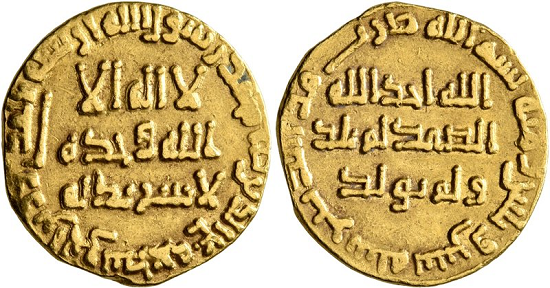
Gold Dinar of Marwan
Not credited, Public domain, via Wikimedia Commons
The institution of the Caliphate was introduced after the death of Prophet Mohammed. There was no fixed successor to Mohammad so the Ummah decided to make the close associates and relatives of Muhammad the caliph. Abu-Bakr was the first caliph; he was a close associate of Muhammad. The Umayyad caliph ruled from 661CE to 750CE. It was the first dynasty to make the institution of the Caliphate an inherent title. They expanded the empire many fold and the Umayyad dynasty became an imperial power with vast military strength. The expansion and some policies of the Umayyads were not supported by all the Muslim sects. The Abbasids who were descendants of Muhammad's uncle fought and defeated the Ummahyads and started the Abbasid dynasty.
Q1. Who were the Abbasids?
Ans. Abbasids claimed to be the descendants of Muhammad’s uncle Abbas. They claimed their inheritance right to the Caliphate and with the joined forces of Arabs, they defeated the Umayyad dynasty.
Q2. Who started the Umayyad Dynasty?
Ans. Umayyad dynasty was founded by the cousin and a close associate of the Caliphate Umar, Muawiyya. Muawiyya was the governor of Syria during the empire of the Rashidun Caliphate.
Q3. What were the major changes were brought during the Umayyad dynasty?
Ans. Umayyads brought many changes −
They introduced the hereditary succession of power.
They made Arabic the official language.
New coins were introduced.
Military power extended.
Q4. What changes were done to new coins?
Ans. New coins were introduced by Abd-al-Malik in 697 CE. Earlier coins had figurines on them like the Byzantine and Sasanian coins. New coins were minted with Arabic religious inscription, date and the location of the mint.
Q5. What were the major architectures built by Abd-al-Malik?
Ans. Abd-al-Malik, built the Dome of Rock in Jerusalem, the building was inscribed with gold and blue mosaic and it was one of the most exceptional buildings ever built. He also built a mosque called Aqsa Mosque, which is considered the third holiest mosque for Muslims, after Mecca and Madina.